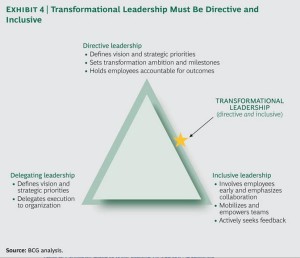For leaders in large corporations, business today often feels like being on a steep treadmill with the speed control set to max. Three months ago, the company may have finished a cost-reduction transformation to remove management layers and streamline operations. Before it is even clear that the changes have taken root, a disruption in Asia requires implementing a new go-to-market model for several countries. And right around the corner is another large-scale transformation effort, using new digital technology to improve the delivery of services and tap new revenue streams.
Welcome to the era of “always-on” transformation. Across virtually all industries, unprecedented disruption and market turbulence—due to globalization, technological innovation, changing regulations, and other factors—are challenging established business models and practices, and requiring organizations to launch more frequent transformations in response. To keep up, companies need to undertake many different types of transformation. Any one of these, or several, can be under way at a company at any given time. BCG’s research shows that 85 percent of companies that have undertaken transformations over the past decade have pursued more than one type, with the most common being organizational, operational, and rapid financial improvements.
We define a transformation as a profound change in a company’s strategy, business model, organization, culture, people, or processes—either enterprise-wide or within a specific business unit, function, or market. A transformation is not an incremental shift in some aspect of the business but a fundamental change aimed at achieving a sustainable, quantum improvement in performance and, ultimately, shareholder value. (For an explanation of BCG’s transformation framework, see Transformation: The Imperative to Change, BCG report, November 2014.) Unlike continuous improvement—which focuses on small-scale changes that start with employees and percolate up through the organization—always-on transformation requires a series of much larger, interdependent initiatives that are driven by top management.
In this new era, the ability to implement transformation has become a competitive differentiator. Yet most companies are not reaping rewards from transformation efforts. According to BCG’s analysis, only 24 percent of companies that complete transformations outperform competitors in their industries in both the short and long term. Whether the objective is rapid bottom-line improvements or more fundamental changes to business and operating models, company leaders need a more effective approach. Rather than focusing on short-term targets alone (for example, a 20 percent improvement in operating efficiency), companies need to go much deeper in order to sustainably improve performance through individual transformations and to ingrain the ability to transform so as to meet future needs. In this report, we discuss the main reasons that the current approach to transformation falls short, and we describe specific changes that organizations can make to achieve better results. Specifically, we discuss six organizational imperatives that companies need to focus on—along with new roles for HR and leadership—in order to thrive in the era of always-on transformation.
Root Causes of Failure
Why do most companies fail to meet their transformation goals? There are several reasons. The first is that companies typically adopt a short-term, top-down approach to implementation. Transformations are energy intensive and are often executed under tremendous pressure from boards and other stakeholders—frequently as a reaction to flagging performance—which leads management teams to seek fast fixes and immediate results. Consequently, many companies simply seek to compel employees to change their behaviors. They motivate through carrots and sticks—mostly sticks—rather than tapping into the intrinsic motivators that can spur employees to improve performance in a sustainable manner.
Second, successful transformations increasingly require changes to business and operating models, which in turn require new ways of thinking and working. Yet more often than not, companies fail to build the capabilities required to enable people to work in new and different ways. Without adequate attention to enabling new behaviors and ways of working, companies do not achieve and sustain the results they desire.
A third reason underlying the failure to reach transformation goals is that many companies approach transformation in a one-off manner—treating each initiative as an independent event. Under this flawed thinking, they essentially put up scaffolding around one aspect of the organization, focus intently on changing some part of it, and then take down the scaffolding, thinking that they can revert to steady-state operations.
This kind of short-term, one-off approach is akin to the way some schools prepare students for standardized tests. In an attempt to improve test scores, teachers try to cram knowledge into students’ heads—basically “teaching to the test” for a few frenzied weeks leading up to the tests. That approach can work—scores often do go up to meet the short-term objective of doing well on the tests—but it doesn’t meet the fundamental goals of education: making sure students learn the underlying skills that will help them succeed over the long term.
Six Key Imperatives
Inspire through purpose
Sustain employees’ energy
Build pivotal capabilities
Establish an agile culture
Instill a learning mind-set
Embed change management
Authors:
• Jim Hemerling, Senior Partner & Managing Director, San Francisco
• Diana Dosik, Principal, New York
• Shaheer Rizvi, Project Leader, New York
